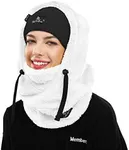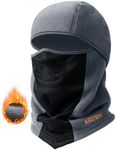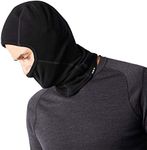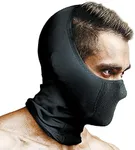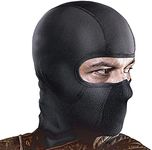Buying Guide for the Best Balaclavas For Women
Choosing the right balaclava can make a significant difference in comfort and performance, especially in cold weather. Balaclavas are versatile headgear that can be used for various activities such as skiing, snowboarding, hiking, or even just for daily use in cold climates. When selecting a balaclava, it's important to consider several key specifications to ensure you get the best fit and functionality for your needs.MaterialThe material of a balaclava is crucial as it determines the warmth, breathability, and comfort. Common materials include wool, fleece, and synthetic fabrics like polyester or spandex. Wool and fleece are excellent for warmth and are often used in colder climates. Synthetic fabrics are usually more breathable and moisture-wicking, making them suitable for high-intensity activities. Choose a material based on the primary use of the balaclava and the climate you will be in.
Fit and SizeA well-fitting balaclava should cover your head, neck, and sometimes shoulders without being too tight or too loose. It should fit snugly to provide warmth and protection but also allow for comfortable movement. Balaclavas come in various sizes, so it's important to check the sizing chart provided by the manufacturer. If you plan to wear it under a helmet, ensure it is thin enough to fit comfortably without causing pressure points.
Design and CoverageBalaclavas come in different designs, offering varying levels of coverage. Some cover the entire face, while others leave the eyes, nose, or mouth exposed. Full-face balaclavas provide maximum protection against the cold and wind, making them ideal for extreme weather conditions. Those with openings for the eyes or mouth are better for activities requiring more ventilation or communication. Consider the level of coverage you need based on your activity and personal preference.
BreathabilityBreathability is important to prevent overheating and moisture buildup, especially during physical activities. Look for balaclavas with breathable fabrics or mesh panels that allow for better airflow. This is particularly important if you plan to use the balaclava for sports or other high-intensity activities. A breathable balaclava will keep you comfortable by allowing sweat to evaporate and reducing the risk of feeling clammy.
Moisture-WickingMoisture-wicking properties help keep you dry by drawing sweat away from your skin. This is essential for maintaining warmth and comfort, as wet fabric can make you feel colder. Balaclavas made from synthetic materials like polyester often have good moisture-wicking capabilities. If you are engaging in activities that cause you to sweat, such as skiing or running, a moisture-wicking balaclava will help you stay dry and comfortable.
Wind and Water ResistanceWind and water resistance are important features for protecting against harsh weather conditions. A wind-resistant balaclava will shield you from cold gusts, while water resistance will keep you dry in light rain or snow. These features are particularly useful for outdoor activities in unpredictable weather. If you expect to be in windy or wet conditions, look for balaclavas with these protective properties to ensure you stay warm and dry.
VersatilitySome balaclavas are designed to be versatile and can be worn in multiple ways, such as a neck gaiter, face mask, or beanie. This versatility can be beneficial if you need a multifunctional piece of gear. Consider how you plan to use the balaclava and whether a versatile design would be advantageous for your activities. A versatile balaclava can provide more value by adapting to different needs and conditions.

